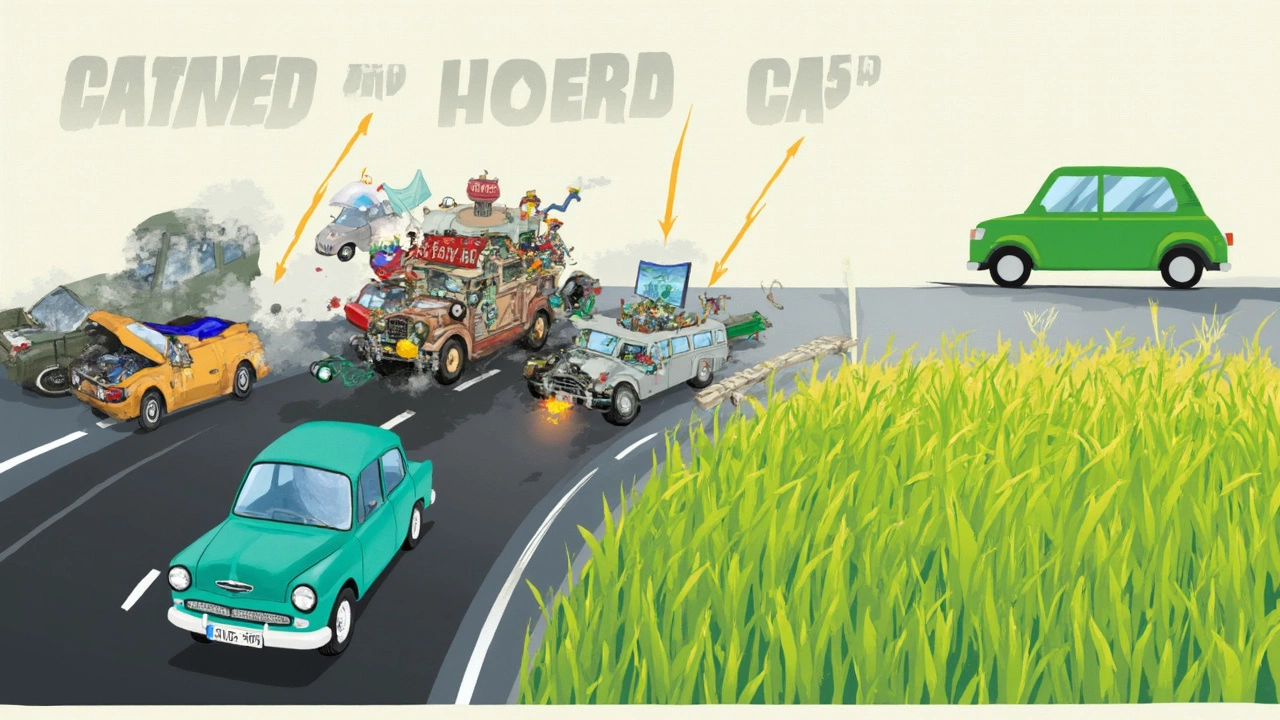 Mar, 25 2025
Mar, 25 2025
Have you ever wondered why certain vehicles just can't be seen on Indian roads anymore? It's not just about preferences; it's about regulations. You see, there's a whole bunch of official rules that make sure only certain types of cars and bikes are allowed to roam around.
One major reason for taking vehicles off the road is their age and the pollution they cause. Diesel vehicles older than 10 years and petrol vehicles older than 15 are a no-go in cities like Delhi. Authorities are cracking down on emissions, making sure that old clunkers don't add to the smoggy skyline we’re all tired of.
And it’s not just the ancient engines; modified vehicles are under strict watch too. You can't just slap on a roaring exhaust or tweak your ride's height unless you want to get it banned. Car mods might sound exciting, but safety comes first for the regulators.
- Old and Emission-Failing Vehicles
- Modified and Unsafe Cars
- Regional Restrictions
- Impact on Manufacturers and Consumers
Old and Emission-Failing Vehicles
It’s no secret that pollution is a big deal in India. That’s why certain vehicles, especially the old ones, are banned to keep the air cleaner. Two things get these vehicles on the banned list: age and emissions. Let's break it down.
Age Restrictions
In major cities like Delhi, diesel vehicles older than 10 years and petrol vehicles older than 15 years are automatically banned. Why? Because older engines are notorious polluters. They weren't built to meet today’s strict emission standards, which means they put out more harmful stuff into the air.
Emission Standards
India has a set of emission standards known as Bharat Stage (BS) norms. With BS6 being the latest, these rules specify the maximum allowable output of pollutants from a vehicle's exhaust. Vehicles not meeting these standards are not allowed on the road, plain and simple. It's all about minimizing the impact on our already strained environment.
Enforcement Measures
Authorities enforce these bans through regular checks and failure to comply can lead to heavy fines. If a vehicle's emission doesn't meet the specified standard, it might get impounded. So, keeping your vehicle in line with the latest norms isn’t just good for the environment, it’s good for your wallet too.
Impact on the Market
These rules have a knock-on effect on the automobile manufacturing scene. Manufacturers now focus on producing vehicles that comply with BS6 norms, driving innovation and new technologies. Plus, there’s a push for electric vehicles, which produce zero emissions. Nice, right?
| Norm | Effective Year | Reduction in Emissions |
|---|---|---|
| BS-IV | 2017 | 60% |
| BS-VI | 2020 | 90% |
It's looking positive for cleaner air, but it means we have to keep an eye on those vehicle life cycles. Because ultimately, the goal is fewer emissions and greener roads.
Modified and Unsafe Cars
When it comes to vehicle modifications, India has some pretty strict rules. Sure, a pimped-out ride might look cool, but if it doesn't meet safety standards, it might be distracting or even dangerous on the road.
Let's talk about a few reasons why certain modified vehicles end up on the banned list:
1. Unauthorized Structural Changes
This is a major red flag. If you've seen vehicles with extra-large wheels or significantly altered bodywork, these could be a cause for concern. Such modifications might affect the stability or alter the dynamics of a car dangerously. In India, structural changes without regulatory approval are a no-go.
2. Altered Engine Capacity
Some enthusiasts love to tweak the engine to boost performance. However, any increase in engine power or capacity beyond what's stated in the registration document can make the vehicle illegal. This is because it may compromise the vehicle's emissions and overall functionality.
3. Non-Approved Accessories
Installing loud exhaust systems, fancy under-glow lights, or oversized bumpers could get your vehicle flagged. While these might seem harmless, they often violate noise pollution standards and can be distracting or outright unsafe on the road.
To drive this home, the Ministry of Road Transport and Highways makes it clear: vehicles on the road must adhere to the specifications defined by the manufacturer unless specifically approved by an authorized test agency.
It's not just about safety—it's about keeping the streets safer for everyone. If you're thinking of modifying your ride, it's best to stick to legal tweaks and always check with local regulations. You don’t want your pride and joy to be amongst those banned vehicles in India.

Regional Restrictions
When it comes to banned vehicles in India, regional restrictions play a big role in what can and can't hit the roads. Think of it as a patchwork of rules where each state might have its own way of doing things. Let’s check out a few areas where the restrictions stand out.
Delhi NCR: The Pollution Crackdown
In the Delhi NCR region, the focus is pretty heavy on keeping the air cleaner. That's why diesel vehicles older than 10 years and petrol vehicles older than 15 years are shown the exit ramp. This aggressive stance is all about cutting down the insane pollution levels that famously blanket the capital.
Maharashtra: No Tolerance for Noise
In Maharashtra, the government is serious about more than just emissions. Modified exhaust systems that make cars sound like they're ready for a drag race are a big no-no. This means if your ride sounds louder than a rocket launching, you’d better expect some fines coming your way.
Kolkata: Tackling Congestion
Kolkata's got another challenge — dealing with urban congestion. The city often restricts the entry of heavy commercial vehicles during peak hours to ease traffic woes. It's not just about keeping the air clean but also about making sure commuters don't spend eternity stuck in jams.
Special Cases: State-Level Variations
There's also a bunch of state-specific rules that might surprise you. For instance, some states have unique tax structures that unfavor certain massive SUVs by making them financially unattractive due to higher taxes. This indirectly impacts what kinds of vehicles folks choose to drive.
Quick Glance: What Can You Do?
- Check local regulations before buying or modifying a vehicle.
- Keep an eye on emission norms especially if you plan to drive your old car across state lines.
- Stay updated with the RTO announcements in your area for any sudden changes that might affect your vehicle.
Impact on Manufacturers and Consumers
For manufacturers, these bans might seem like a storm cloud overhead, but there's a silver lining. Banning banned vehicles in India pushes the auto industry to innovate. This means rolling out Hybrids, EVs, and other greener vehicles, helping everyone breathe a bit easier.
Manufacturers are increasingly adopting cleaner tech and stricter compliance measures. For instance, many companies have jolted their production lines with newer, emission-friendly models. This shift not only helps cut down on pollution but also meets the high expectations of environmentally aware consumers.
"Our commitment towards greener transport solutions is vital," said Ratan Lal, CEO of a prominent automotive firm. "Consumers now prefer vehicles that are both efficient and environment-friendly."
On the flip side, consumers face a mixed bag of reactions. While some lament the loss of beloved old vehicles, others welcome the change for cleaner air. The younger population, especially in urban areas, is pivoting their preference towards high-tech vehicles that tick the green box.
What Can Consumers Do?
With these regulations, what's a savvy buyer to do? First things first: check the vehicle's emission compliance. Opt for vehicles that meet the latest Bharat Stage (BS) norms, currently at BS6. This ensures you’re on the right side of the law and doing your bit for the planet.
A growing trend is the popularity of electric vehicles (EVs), which are not only eco-friendly but often come with perks like tax benefits and subsidies. Here’s a quick suggestion for you: always be ahead of the game and research incentives offered in your region.